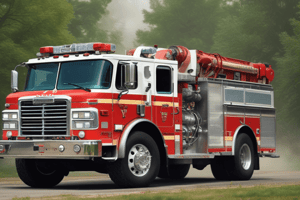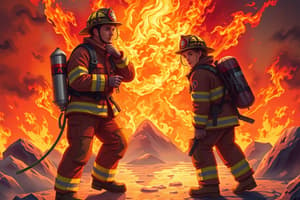Podcast
Questions and Answers
What is the primary focus when performing a controlled aggressive attack during firefighting?
What is the primary focus when performing a controlled aggressive attack during firefighting?
- Evacuating all personnel immediately
- Reducing the number of personnel on the fireground
- Assessing structural integrity of buildings
- Directing water on the fire from effective positions (correct)
In what circumstance can personnel be engaged in exceptionally hazardous situations according to the risk management plan?
In what circumstance can personnel be engaged in exceptionally hazardous situations according to the risk management plan?
- For routine inspections of the fireground
- For assessing additional risks without immediate action
- To perform a rescue while limiting personnel exposure (correct)
- When it is safe to do so without protective equipment
Which of the following statements aligns with the risk management plan regarding risking lives?
Which of the following statements aligns with the risk management plan regarding risking lives?
- We risk our lives indiscriminately for any potential victim.
- We may risk our lives a little to protect savable property. (correct)
- We risk our lives as a first priority, regardless of circumstances.
- We risk our lives only if property is immediately savable.
What is the recommended positioning strategy for personnel operating defensively?
What is the recommended positioning strategy for personnel operating defensively?
What is the consequence of personnel not being assigned to a task at the fireground?
What is the consequence of personnel not being assigned to a task at the fireground?
Why is it important to limit the number of personnel on the fireground?
Why is it important to limit the number of personnel on the fireground?
What should be prioritized during operations involving structures with potential hazards?
What should be prioritized during operations involving structures with potential hazards?
How should personnel operate in relation to barriers when possible?
How should personnel operate in relation to barriers when possible?
What should be utilized to avoid conflicting operations during firefighting?
What should be utilized to avoid conflicting operations during firefighting?
Before ladder pipes go into operation, what action should Command or Sector Officers consider?
Before ladder pipes go into operation, what action should Command or Sector Officers consider?
How should exterior master streams be operated in relation to interior crews?
How should exterior master streams be operated in relation to interior crews?
When laddering a roof, how far should the ladder extend above the roof line?
When laddering a roof, how far should the ladder extend above the roof line?
Where should ladders be placed when building under fire conditions?
Where should ladders be placed when building under fire conditions?
When is it essential for personnel to be tethered to a ladder/platform anchorage point?
When is it essential for personnel to be tethered to a ladder/platform anchorage point?
What is the minimum requirement for escape routes when operating above or below ground level?
What is the minimum requirement for escape routes when operating above or below ground level?
What is a critical action that must be taken before operating exterior hand line applications?
What is a critical action that must be taken before operating exterior hand line applications?
What strategy emphasizes the importance of maximizing distance from hazardous areas while remaining effective?
What strategy emphasizes the importance of maximizing distance from hazardous areas while remaining effective?
What is the primary goal of limiting personnel on the fireground?
What is the primary goal of limiting personnel on the fireground?
Command's strategy during rescue operations in hazardous areas should focus on what?
Command's strategy during rescue operations in hazardous areas should focus on what?
Which of the following conditions would warrant a controlled aggressive attack?
Which of the following conditions would warrant a controlled aggressive attack?
What should not occur in the context of fireground operations according to the standard risk management plan?
What should not occur in the context of fireground operations according to the standard risk management plan?
During exceptionally hazardous conditions, how should Command handle personnel engagement?
During exceptionally hazardous conditions, how should Command handle personnel engagement?
What should be the focus in firefighting operations when large equipment is present?
What should be the focus in firefighting operations when large equipment is present?
For what purpose should water be applied to a fire during an interior attack?
For what purpose should water be applied to a fire during an interior attack?
What is the main purpose of utilizing radio or face-to-face communications during firefighting operations?
What is the main purpose of utilizing radio or face-to-face communications during firefighting operations?
What is the recommended action for Company and Sector Officers before ladder pipes are utilized?
What is the recommended action for Company and Sector Officers before ladder pipes are utilized?
What should be avoided when operating exterior master streams?
What should be avoided when operating exterior master streams?
How should ladders be positioned to enhance safety during a fire emergency?
How should ladders be positioned to enhance safety during a fire emergency?
When is it necessary for personnel to be tethered to a ladder or platform anchorage point?
When is it necessary for personnel to be tethered to a ladder or platform anchorage point?
What should be done before ground crews are evacuated from interior positions?
What should be done before ground crews are evacuated from interior positions?
What is critical to establish when operating above or below ground level?
What is critical to establish when operating above or below ground level?
What aspect of coordination is crucial for preventing conflicting operations during firefighting?
What aspect of coordination is crucial for preventing conflicting operations during firefighting?
Flashcards are hidden until you start studying
Study Notes
Standard Risk Management Plan Overview
- Life risks are assessed based on potential to save lives or property, guiding response strategies.
- Protecting savable lives may involve high-risk actions, while protecting property involves lower risks.
- No risks are taken for lives or property deemed already lost.
Defensive Strategy
- Maintain maximum distance from hazardous areas while being effective.
- Utilize barriers like fences and walls for safety during operations.
- Reduce exposure to sudden hazards such as explosions, structural collapses, and heavy equipment collisions.
Offensive Strategy
- Engage in controlled aggressive attacks to ensure firefighter safety.
- Coordinate interior attack effectively to suppress fires and minimize safety hazards.
- Focus on applying water to the fire from the best available position, enhancing safety for victims and firefighters.
Personnel Management on Fireground
- Limit personnel presence on the fireground to essential functions to reduce confusion and hazards.
- Personnel roles include responding, staging, task assignment, or being released to in-service status.
- Avoid wandering or forming non-functional groups; non-assigned personnel must stay outside the perimeter.
Engaging in Hazardous Situations
- In critical rescue scenarios, minimize personnel exposure while ensuring safety measures are in place.
- Use unmanned fire streams (master streams) whenever feasible in highly hazardous areas.
- Ensure clear communication between crews operating in conflicting positions to prevent injuries.
Operational Coordination
- Notify ground crews before activating ladder pipes and ensure a Personnel Accountability Report (PAR) is obtained when needed.
- Avoid directing exterior master streams into areas with interior crew operations to protect firefighter safety.
- Caution when using exterior hand lines to avoid impacting interior crews.
Laddering and Escape Protocols
- When laddering roofs, select ladders that extend 2-3 feet above the roofline for safe egress.
- Position ladders near stable areas like building corners to enhance safety during structural failures.
- Personnel must be tethered to a secure anchorage when working on platforms or ladders, with specific safety protocols in place.
Escape Route Requirements
- Establish at least two escape routes when operating above or below ground level, ideally at opposite ends of the building or separated by significant distance.
Standard Risk Management Plan Overview
- Life risks are assessed based on potential to save lives or property, guiding response strategies.
- Protecting savable lives may involve high-risk actions, while protecting property involves lower risks.
- No risks are taken for lives or property deemed already lost.
Defensive Strategy
- Maintain maximum distance from hazardous areas while being effective.
- Utilize barriers like fences and walls for safety during operations.
- Reduce exposure to sudden hazards such as explosions, structural collapses, and heavy equipment collisions.
Offensive Strategy
- Engage in controlled aggressive attacks to ensure firefighter safety.
- Coordinate interior attack effectively to suppress fires and minimize safety hazards.
- Focus on applying water to the fire from the best available position, enhancing safety for victims and firefighters.
Personnel Management on Fireground
- Limit personnel presence on the fireground to essential functions to reduce confusion and hazards.
- Personnel roles include responding, staging, task assignment, or being released to in-service status.
- Avoid wandering or forming non-functional groups; non-assigned personnel must stay outside the perimeter.
Engaging in Hazardous Situations
- In critical rescue scenarios, minimize personnel exposure while ensuring safety measures are in place.
- Use unmanned fire streams (master streams) whenever feasible in highly hazardous areas.
- Ensure clear communication between crews operating in conflicting positions to prevent injuries.
Operational Coordination
- Notify ground crews before activating ladder pipes and ensure a Personnel Accountability Report (PAR) is obtained when needed.
- Avoid directing exterior master streams into areas with interior crew operations to protect firefighter safety.
- Caution when using exterior hand lines to avoid impacting interior crews.
Laddering and Escape Protocols
- When laddering roofs, select ladders that extend 2-3 feet above the roofline for safe egress.
- Position ladders near stable areas like building corners to enhance safety during structural failures.
- Personnel must be tethered to a secure anchorage when working on platforms or ladders, with specific safety protocols in place.
Escape Route Requirements
- Establish at least two escape routes when operating above or below ground level, ideally at opposite ends of the building or separated by significant distance.
Studying That Suits You
Use AI to generate personalized quizzes and flashcards to suit your learning preferences.




